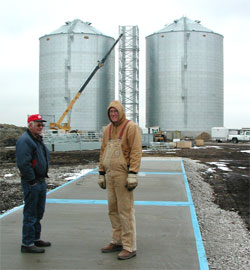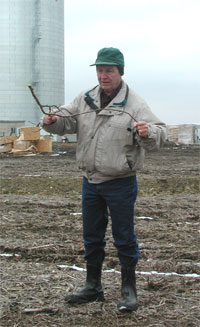New grain terminal being built
Tuesday April 13, 2004 Posted 9:30 p.m.
 Brian Richards on the right poses in front of the grain bins being built for a new grain terminal
north of Rutland.
Brian Richards on the right poses in front of the grain bins being built for a new grain terminal
north of Rutland.
A new grain terminal is being built 6 miles north of Minonk right south of the Santa Fe mainline
railroad. The facility is being built by Rupp Brothers Grain who have grain elevators throughout
the area. Two grain bins with a capacity of 325,000 bushels each have already been built to
store the grain that will be brought in from farmers throughout the area. Brian Richards,
manager of the new operation, said there will be another smaller grain bin with a capacity of 50,000
bushels that will be built for mixing grain.
Richards said that 7800 feet of railroad track will be laid to accommodate up to 110 grain cars to
transport the grain to feedlots in Hereford, Texas. He said the track will be laid in a loop that will adjoin
the Santa Fe tracks running north of the facility. Richards said that grain from the huge bins will be
loaded into the cars at least once a week. When the cars are filled, Santa Fe engines will pull empty
cars for the next trip and take the newly loaded cars down the Santa Fe mainline. The grain shipped to Texas
will not only be used as feed for cattle but also will be used in the production of ethonal at the ethonal
plants in Texas. In addition, the glutin byproduct from the ethonal will also be used as feed for the cattle.
The grain bins are around 150 feet high and were built from the bottom up, one section at a time. First
the roof was built. It was then jacked up so that a section of the bin could be attached underneath the
roof. Successive wall units were built in similar manner with jacks raising up each newly completed section
to allow the next section to be attached from the bottom.
 Eldon Folkerts witches for water at site of new grain terminal.
Eldon Folkerts witches for water at site of new grain terminal.
Minonk resident Eldon Folkerts was brought in to try to find a source of water for
drilling a new well for the new grain terminal. Previously,
two dry wells had been dug. Folkerts has been
witching for waters for years with an apple branch and was summoned to see if he could find water that was
no more than 80 feet deep. Folkerts found a spot that he thought should have a water vein about 70 feet
down. However, drilling in that spot they hit a vein of gravel, but no water. Usually a gravel vein
will contain water. This means that in order to find water, it will be necessary to drill down more than
80 feet.
Folkerts witches for water by using a y shaped apple branch freshly snapped from a tree. He walks with
a branch held in each hand with the stem below the crotch facing up. When he passes over a water
vein, the branch will turn down. Folkerts says that he cannot hold the branch up when it starts to turn down.
After the branch turns down, it will start to bob up and down a few inches. Folkerts counts the number of bobs
and multiplies by 10 to get the depth of the water vein.
|
|

